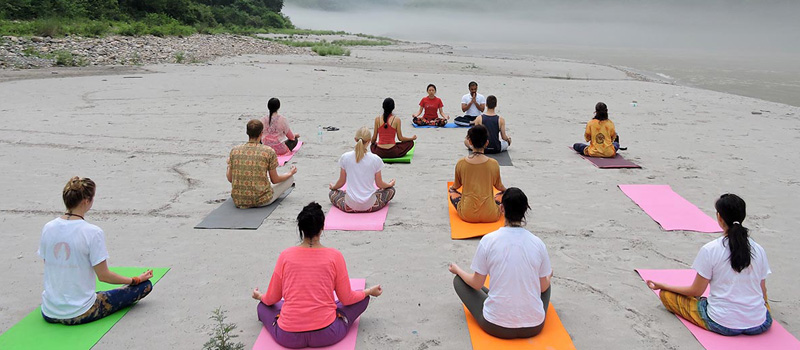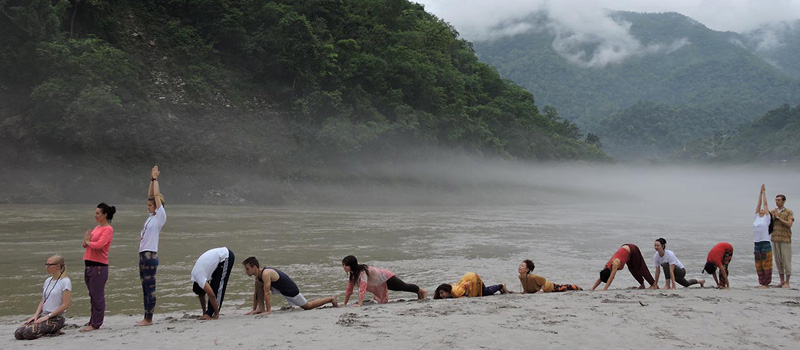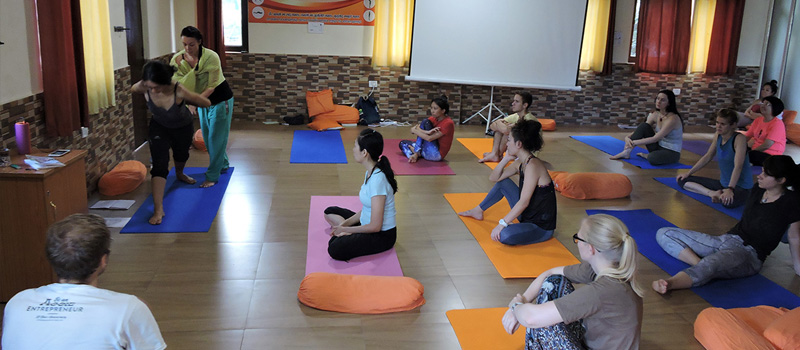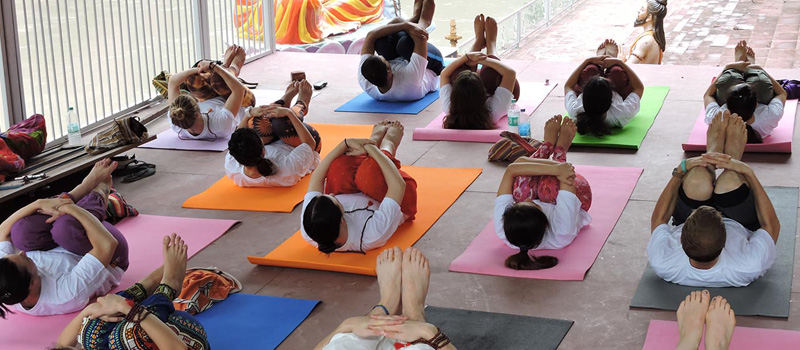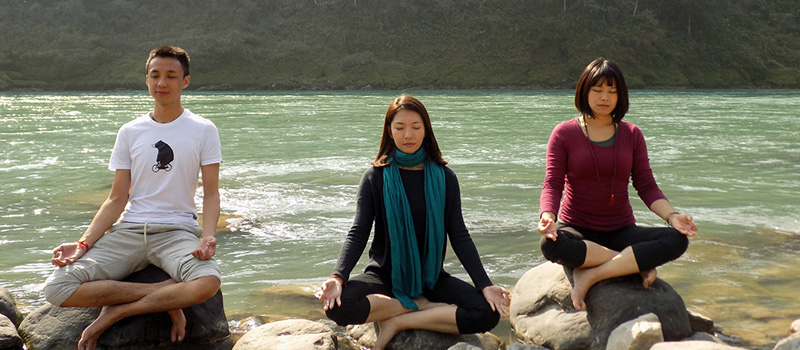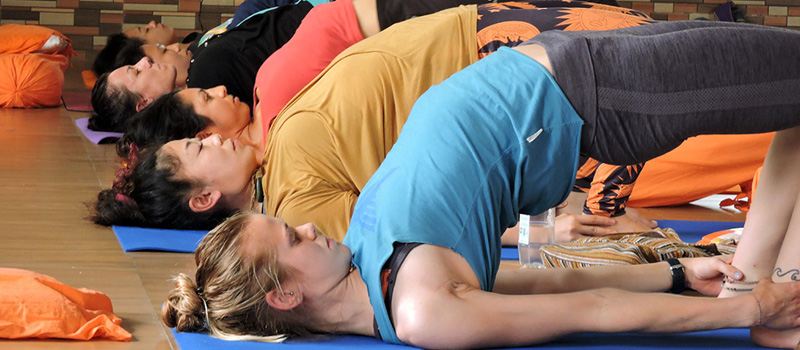The literal meaning of bandhas means to close, to lock or to stop. The practice of bandha during
Yoga involves restricting the flow of energy to one part of the body and then redirecting it. When the lock or bandha is released, the energy is flooded to the other parts of the body with improved intensity. There are three principle bandhas plus one more bandha which ties them all together. The four types of bandhas are as follows:
Jalandhara Bandha (throat lock) - The throat lock or the chin lock restrict the flow of energy in the upward direction. The jalandhara bandha emerges during the time of holding of breath. But it can be practiced without holding the breath as well.
Sit down in a meditative pose and get your head, neck and trunk aligned.
Elevate the sternum and upper rib cage gently towards the chin.
Lower your chin and jaw placing them onto the area between the two collar bones. If you cannot reach this area, you can place a clean rolled towel under the chin.
Make sure not to tense up any part of the neck, tilt it or force or strain the chin to the chest.
Take five breaths and then raise your head back to the starting position.
Benefits of jalandhara bandha- The jalandhara bandha is a very powerful bandha and it exerts pressure on the sinuses on the main arteries of the neck which in turn helps in regulating the respiratory and the circulatory system. This pressure helps in balancing the metabolism as well as the thyroid gland. It is a great bandha to try if you are having a sudden anger fit as it helps in relieving stress and anger while imparting a relaxing feeling.
Precautions:
This bandha is not meant to be practiced by those suffering from breathing problems or high or low blood pressure.
People with stiff neck should keep their head only as far down as possible. Do not strain the neck too much. You can also roll a towel and place it on top of the collarbone.
Always hold this bandha by lifting up your chest and not by putting your chin down.
Do not force your chin to your sternum.
Mula bandha (root lock) - The pelvic floor is a diamond-shaped area which comprises of the anus, the genitals and the perineum. The mula bandha is acquired by pulling the perineum inward. ,
Sit in an upright, meditative pose.
Inhale and contract your pelvic floor muscles upward and inward. Now, exhale and release the muscles. Repeat this procedure ten times.
Repeat the same contractions but this time with reversed breathing. Contract the muscles on exhalation and release the muscles on inhalation.
Now focus only on your perineum which is the area between the anus and the genitals. Contract the area when you inhale and release it when you exhale.
Now reverse the breathing pattern- contract the muscles with exhalation and relax them with inhalation.
Keep practicing the session until you can separate the perineum while it contracts and repeat it 10 or more times.
Benefits of mula bandha- The mula bandha stimulate the pelvic nerves, the endocrine system, the genital system and the excretory system. It is also known for relieving constipation and depression.
Precautions:
Mula bandha should not be performed by pregnant women.
If performed incorrectly it may affect the digestive system adversely.
People suffering from piles, hernia, etc. should avoid this bandha as much as possible.
In severe cases of constipation or when the lower abdomen is already tightened, mula bandha should be avoided.
An intensive practice of mula bandha should only be performed under the guidance of an experienced teacher or instructor only.
Uddiyana bandha (stomach lock) - The meaning of the word uddiyana means "flying up". In the uddiyana bandha the breath is held out while contracting the abdominal wall inward and the contents of the abdomen upward. This way a hollow is created at the base of the rib cage. The release of contraction is followed by inhalation. It is of utmost importance to follow the steps of this practice very carefully and the breathing should not be restricted for a very long time without the guidance of a teacher.
Stand with your feet two feet apart, knees bent and hands rested on the thighs just above the knees. Keep the elbows straight and the upper body weight on the arms.
Exhale and hold the breath out.
Now draw the abdominal wall in and up. Make sure not to exert excess strain.
Hold it for a few seconds and gently release the abdomen.
After releasing the abdomen completely, inhale gently and slowly.
Once you start breathing smoothly, repeat this not more than 2 times.
Benefits of uddiyana bandha- Uddiyana bandha is the perfect cure for abdominal and stomach related ailments such as indigestion, constipation, etc. It stimulates the flow of digestive juices thus improving the metabolism as well as tones the overburdened abdominal organs. It also balances your adrenal system, relieves tension, lethargy and stress.
Precautions:
People with high blood pressure should not perform this bandha.
Menstruating and pregnant women should not practice it.
People suffering from stomach ailments, heart diseases or blood pressure should not perform this bandha. People suffering from hernia should also avoid this bandha.
Maha bandha- Maha bandha is the combination of all the three above mentioned bandhas.
Sit down at a comfortable place, cross-legged or on your shins and palms resting on thighs or knees.
Take a complete breath through your nose and exhale even the last trace of air out of your lungs.
Now without taking in any air engage your mula bandha and then the uddiyana bandha.
Inhale a little bit air and engage in jalandhara bandha.
Hold on the bandhas for as long as you can and then slowly release.
Benefits of maha bandha- With maha bandha, you can get the benefits of all the three bandhas and regulate the endocrine system entirely.
Precautions:
The above-mentioned precautions for each of the three bandhas are applicable for maha bandha.

